Research Article - Archives of Clinical and Experimental Surgery (2022)
Evaluation of the Association between Breast Imaging Reporting and Data System for Ultrasonography (BIRADS) and Histopathology in Patients of Lump nn Breast: An Observational Study
Samprati Dariya*, Sonia Moses, Sachin Verma, Prakhar Chaudhary and Sarvagya JainSamprati Dariya, Department of General Surgery, MGM Medical College and M.Y. Hospital, Indore, India, Tel: 9461847242, Email: Sampratidariya95@gmail.com
Received: 29-Apr-2022, Manuscript No. EJMACES-22-63498; Editor assigned: 02-May-2022, Pre QC No. EJMACES-22-63498 (PQ); Reviewed: 17-May-2022, QC No. EJMACES-22-63498; Revised: 23-May-2022, Manuscript No. EJMACES-22-63498 (R); Published: 30-May-2022
Abstract
Background: Breast cancer is one of the leading causes of cancer amongst women in India. Secondary prevention comprising of triple test (clinical, radiological and non- excision biopsy) helps in early detection of breast cancers. A concordant triple test is 100% sensitive and 100% specific to detect the malignant lesions. Diagnostic and management dilemma arises when triple test is non-concordant especially when ultrasonography denotes lump as probably benign and clinical and non-excision biopsy as benign. These patients are in constant state of anxiety about possibility of malignancy. Standard protocol at present is either to follow up the lump at 6 months interval with ultrasonography for a period of 2 years or to excise the lump and confirm with histopathology. Present study is focussed on diagnostic accuracy and predictive value of the ultrasonography in similar scenario.
Methods: The study design is an observational cohort study conducted from January 2021 to September 2021 in MGM Medical College, Indore on patients presenting to outpatient unit of surgery department with lump in the breast. A total of 60 patients were included. The objective of our study was to compare the result of radiological BIRADS Score with that of histopathology and calculate sensitivity, specificity, positive and negative predictive value.
Results: The sensitivity of BIRADS in the diagnosis of carcinoma of breast was 91.67%, specificity was 88.89%, positive predictive value was 84.62%, negative predictive value was 94.12% and diagnostic accuracy is 90%.
Conclusion: There is 6% probability of a benign lump as per BIRADS score to be malignant and 15% chances of a radiological malignant lump to be benign.
Keywords
Breast imaging reporting and data system, Breast lump, correlation, Histopathology, Triple assessment
Introduction
Breast lump is one of the most common problems encountered by women who are presenting to breast clinics. Although, most of these lumps are benign but presence of lump can cause anxiety because of concern for cancer. The most important work of the surgeon evaluating a breast mass is to provide a comprehensive, efficient and timely consultation in order to relieve anxiety, exclude the presence of malignancy, and provide an accurate diagnosis with appropriate treatment plan if diagnosed with cancer. Every breast lump is not malignant and every benign lump do not progress to cancer; nevertheless the precision of the final diagnosis can be greatly increased by using triple assessment; radiological imaging (mammography, ultrasonography) and pathological diagnosis along with clinical examination.
The Breast Imaging Reporting and Data System (BIRADS) lexicon was developed by the American College of Radiology for interdisciplinary standardization in communication between radiologists and surgeon and to correlate between radiological and pathological findings of a breast lump and make sui diagnosis and treatment plan [1].
The present study is to evaluate the diagnostic accuracy of BI-RADS (Breast Imaging Reporting and Data System) by using radiological procedures like ultrasound with histopathological finding in diagnosis of benign and malignant lumps in order to determine the reliability of BIRADS which may avoid unnecessary aggressive interventions for typically benign lesion or may alert to perform surgical intervention for malignancy on time.
Aim of our study is to evaluate the association between BIRADS categories and histopathology classification of breast lump.
The objective is to correlate between the BIRADS Score and the histopathological finding in woman with lump in breast presenting in our institute and to check Sensitivity, Specificity, Positive and Negative predictive value of BIRADS scoring in predicting malignancy.
Materials and Methods
This is an Observational cohort study conducted from January 2021 to September 2021 on all patients presenting in the Department of Surgery of MGM Medical College and MY Hospital with complaint of lump in breast. Sample sizes of 60 patients are taken after taking voluntary informed consent.
Inclusion criterion
• Female patients presenting to department of surgery with lump in breast.
• Patients who have undergone BIRADS categorization of their lump using Ultrasonography.
• Patients who wish to undergo biopsy of their lump for histopathology.
Exclusion criterion
• Patients who have undergone previous breast surgery or recurrent case.
• Patients who are investigated outside our institute.
• Lactating and pregnant female
• Male patients
Detailed record of clinical history and the examination findings are maintained as per standard protocol which includes epidemiological data, duration of symptom, menstrual and obstetric history and history specific to breast lump. BIRADS category for Ultrasonography is assessed in the radiology department and recorded. Findings of triple test noted and patient is categorised as triple negative or triple positive. Results are categorised as benign or malignant.
Triple test negative patient will be identified as having benign lump and they are further counselled as either to undergo observation of lump with 6 monthly follow up for a period of 2 years. During each follow up visit BIRADS category is reassessed for detection of change from previous report. The patient who refuses to undergo observation protocol is subjected for biopsy of lump.
The patients whose histopathology report is available will be the final subject for analysis of data. BIRADS category is grouped into two categories: Benign: Category 1, 2 and 3 and Malignant: Category 4, 5 and 6
Histopathology findings are grouped into two categories 1) Benign and 2) Malignant
Sensitivity, specificity, positive predictive value, negative predictive value of BIRADS will be compared with histopathology.
Results
Distribution according to age
12 (20%) women were in the age ≤ 20 years, 25 (41.7%) were in the age group 21-40 years, 19 (31.7%) were in the age group 41-60 years and 4 (6.7%) were in the age group >60 years. Majority of the women were in the age group 21- 40 years (Figure 1).
12 (20%) women were in BIRADS category 2, 22 (36.7%) were in category 3, 17 (28.3%) were in category 4 and 9 (15%) were in category 5 (Table 1).
| BIRADS Category | Number | Percentage |
|---|---|---|
| Category 2 | 12 | 20.0 |
| Category 3 | 22 | 36.7 |
| Category 4 | 17 | 28.3 |
| Category 5 | 9 | 15.0 |
| Total | 60 | 100.0 |
Of this category 2 and 3 are considered as benign and category 4 and 5 are considered as malignant. There were 34 (56.7%) benign and 26 (43.3%) malignant lesions (Figure 2).
Benign lesions seen on histopathology
On histopathology, there were 22 (36.7%) fibroadenoma, 3 (5%) fibrocystic disease, 4 (6.7%) intraductal papilloma, 3 (5%) tubular adenoma, 2 (3.3%) phylloids, 1 (1.7%) lipoma and 1 (1.7%) mastitis
Malignant lesions seen on histopathology
Invasive duct carcinoma in 18 (30%), invasive papillary carcinoma in 1 (1.7%), mucinous carcinoma in 1 (1.7%) and lobular carcinoma in 4 (6.7%) (Table 2).
| Histopathology | Number | Percentage |
|---|---|---|
| Benign | ||
| Fibroadenoma | 22 | 36.7 |
| Intraductal papilloma | 4 | 6.7 |
| Fibrocystic disease | 3 | 5.0 |
| Tubular adenoma | 3 | 5.0 |
| Phylloides | 2 | 3.3 |
| Lipoma | 1 | 1.7 |
| Mastitis | 1 | 1.7 |
| Malignant | ||
| Invasive duct carcinoma | 18 | 30.0 |
| Invasive papillary carcinoma | 1 | 1.7 |
| Mucinous carcinoma | 1 | 1.7 |
| Lobular carcinoma | 4 | 6.7 |
| Total | 60 | 100.0 |
On histopathology, 36 (60%) lesions were benign and 24 (40%) lesions were malignant (Figure 3).
Of the 12 patients in BIRADS Category 2, 11 (91.7%) were
found to be benign and 1 (8.3%) was malignant.
Of the 22 patients in BIRADS Category 3, 21 (95.5%) were
found to be benign and 1 (4.5%) was malignant.
Of the 17 patients in BIRADS Category 4, 4 (23.5%) were
found to be benign and 13 (76.5%) was malignant.
Of the 9 patients in BIRADS Category 5, 9 (100%) were malignant (Table 3).
| BIRADS Category | Histopathology | Total | |
|---|---|---|---|
| Benign | Malignant | ||
| Category 2 | 11 91.7% |
1 8.3% |
12 100.0% |
| Category 3 | 21 95.5% |
1 4.5% |
22 100.0% |
| Category 4 | 4 23.5% |
13 76.5% |
17 100.0% |
| Category 5 | 0 0.0% |
9 100.0% |
9 100.0% |
| Total | 36 60.0% |
24 40.0% |
60 100.0% |
There was a statistically significant association between BIRADS categories and the histopathological findings (P=0.001), showing that the histopathological findings is dependent on the BIRADS categories (Figure 4) and comparison of BIRADS with histopathology shown in Table 4.
| BIRADS Category | Histopathology | Total | |
|---|---|---|---|
| Benign | Malignant | ||
| Benign | 32 | 2 | 34 |
| Malignant | 4 | 22 | 26 |
| Total | 36 | 24 | 60 |
The above Table shows the Sensitivity, specificity, positive predictive value, negative predictive value and diagnostic accuracy of BIRADS categories against histopathology results in the diagnosis of carcinoma of the breast.
Sensitivity: 91.67% Specificity: 88.89% Positive predictive value: 84.62% Negative predictive value: 94.12% Diagnostic accuracy: 90.00%
The sensitivity of BIRADS in the diagnosis of carcinoma of breast was 91.67%, specificity was 88.89%, positive predictive value was 84.62%, negative predictive value was 94.12% and diagnostic accuracy is 90% (Table 5).
| Age | BIRADS Category | Total | |
|---|---|---|---|
| Benign | Malignant | ||
| ≤ 20 years | 11 91.7% |
1 8.3% |
12 100.0% |
| 21-40 years | 17 68.0% |
8 32.0% |
25 100.0% |
| 41-60 years | 6 31.6% |
13 68.4% |
19 100.0% |
| >60 years | 0 0.0% |
4 100.0% |
4 100.0% |
| Total | 34 56.7% |
26 43.3% |
60 100.0% |
| Pearson Chi-square test applied. Chi-square test=17.395, df=3, P value=0.001, Significant |
|||
The above shows the association between BIRADS category and age.
Of the 12 patients in the age ≤ 20 years, 11 (91.7%) were benign
and 1 (8.3%) malignant according to BIRADS.
Of the 25 patients in the age 21-40 years, 17 (68%) were benign
and 8 (32%) malignant according to BIRADS.
Of the 19 patients in the age 41-60 years, 6 (31.6%) were benign
and 13 (68.4%) malignant according to BIRADS.
Of the 4 patients in the age >60 years, 4 (100%) were malignant
according to BIRADS.
There was a statistically significant association between age and the BIRADS category (P=0.001), showing that the BIRADS category is dependent on the age of the patients (Figure 5).
The incidence of malignancy increased with the increase in the age of the patients.
Of the 12 patients in the age ≤ 20 years, 11 (91.7%) were benign
and 1 (8.3%) malignant on histopathology.
Of the 25 patients in the age 21-40 years, 19 (76%) were benign
and 6 (24%) malignant on histopathology.
Of the 19 patients in the age 41-60 years, 6 (31.6%) were benign
and 13 (68.4%) malignant on histopathology.
Of the 4 patients in the age >60 years, 4 (100%) were malignant
on histopathology (Figure 6).
There was a statistically significant association between age and histopathology findings (P=0.001), showing that histopathology findings is dependent on the age of the patients (Table 6).
| Histopathology | BIRADS Categories | Total | |||
|---|---|---|---|---|---|
| Cat 2 | Cat 3 | Cat 4 | Cat 5 | ||
| Fibroadenoma | 2 9.1% |
16 72.7% |
4 18.2% |
0 0.0% |
22 100.0% |
| Fibrocystic disease | 1 33.3% |
2 66.7% |
0 0.0% |
0 0.0% |
3 100.0% |
| Intraductal papilloma | 3 75.0% |
1 25.0% |
0 0.0% |
0 0.0% |
4 100.0% |
| Lipoma | 1 100.0% |
0 0.0% |
0 0.0% |
0 0.0% |
1 100.0% |
| Mastitis | 0 0.0% |
1 100.0% |
0 0.0% |
0 0.0% |
1 100.0% |
| Phylloides | 2 100.0% |
0 0.0% |
0 0.0% |
0 0.0% |
2 100.0% |
| Tubular adenoma | 2 66.7% |
1 33.3% |
0 0.0% |
0 0.0% |
3 100.0% |
| Invasive duct carcinoma | 1 5.6% |
1 5.6% |
11 61.1% |
5 27.8% |
18 100.0% |
| Invasive papillary carcinoma | 0 0.0% |
0 0.0% |
0 0.0% |
1 100.0% |
1 100.0% |
| Lobular carcinoma | 0 0.0% |
0 0.0% |
2 50.0% |
2 50.0% |
4 100.0% |
| Mucinous carcinoma | 0 0.0% |
0 0.0% |
0 0.0% |
1 100.0% |
1 100.0% |
| Total | 12 20.0% |
22 36.7% |
17 28.3% |
9 15.0% |
60 100.0% |
| Pearson Chi-square test applied. Chi-square test=74.693, df=30, P value=0.001, Significant |
|||||
The incidence of malignancy increased with the increase in the age of the patients (Figure 7).
Discussion
Breast lumps are one of the most common findings in women attending surgical clinics, presence of a lump invokes a sense of fear and insecurity among these women and each lump is believed to be malignant, since breast malignancy is incredibly much amenable to curative treatment when detected early, so it becomes essential that malignancy is detected at earlier stages to allay fear and institute early treatment. Developed in early 1990s, the BIRADS scoring method has been used extensively as a surrogate to histopathological reporting of carcinoma [2].
According to the sixth edition of the BIRADS system, the lesion categories are divided as follows [3]:
• Category 0: Needs additional imaging or previous exams
for comparison
• Category 1: Negative
• Category 2: Benign findings
• Category 3: Probably benign
• Category 4: Suspicious
• Category 5: Highly suggestive of malignant lesion
• Category 6: Being biopsy proven malignancy
Prior to implementation of BIRADS there was an absence of uniformity in reporting of mammography findings and this often resulted in varied reporting and management strategies? This ambiguity had also led to increased difficulties in establishing performance standards across settings. This had been the most impetus in developing the BIRADS system and number of other research studies has shown the classification system to be useful in predicting the likelihood of cancer. These results are seen during this study and hence further show the value of BIRADS in effective management of breast carcinoma.
Age distribution of cases
Majority of the women involved in our study are in the age group 21-40 years (41.70%) and least commonly seen after the age of 60 years, this is similar to the distribution seen in other studies. Younger aged women have more education standards and awareness that lead them to present earlier in the course of disease.
In the present study, it was observed that of the 12 patients in the age ≤ 20 years, 11 (91.7%) were benign and 1 (8.3%) malignant on histopathology. Of the 25 patients in the age 21-40 years, 19 (76%) were benign and 6 (24%) malignant on histopathology. Of the 19 patients in the age 41-60 years, 6 (31.6%) were benign and 13 (68.4%) malignant on histopathology. Of the 4 patients in the age >60 years, 4 (100%) were malignant on histopathology.
Most common benign and malignant lesion
The most common benign lesion in our study is fibroadenoma which accounts for 36.7% of the total cases in the study. The most common malignant lesion in our study is invasive ductal carcinoma (no special type) consisting 30% of of the cases in the study. It is similar to the observations made by many other studies (Table 7).
| Studies | No of cases | Most common age group | Most common benign lesion | Most common malignant lesion |
|---|---|---|---|---|
| Selvi radhakrishna, et al. [4] | 437 | Fifth decade | Fibrocystic change | Invasive ductal carcinoma(NOS) |
| Invl chaitanya, et al. [5] | 100 | Fifth decade | Fibroadenoma | Invasive ductal carcinoma(NOS) |
| Arsalan, et al. [6] | 50 | Fifth decade | Ductal hyperplasia | Invasive ductal carcinoma(NOS) |
| Kim mj, et al. [7] | 71 | Fifth decade | Fibroadenoma | Invasive ductal carcinoma(NOS) |
| Eda elverci, et al. [8] | 186 | Fourth decade | Fibrocystic change | Invasive ductal carcinoma(NOS) |
| Sarangan, et al. [9] | 106 | Fifth and sixth decades | Fibroadenoma | Invasive ductal carcinoma(NOS) |
| Present study | 60 | Third and fourth decade | Fibroadenoma | Invasive ductal carcinoma(NOS) |
Distribution of findings of BIRADS score
The majority of the participants I.e. 22 (36.7%) has breast lesions classified into BI-RADS category 3 that corresponds to likely benign finding. Category 4 is the next most common 17 (28.3%) corresponding to suspicious abnormalities. Amongst benign lesions, the most common BIRADS category in this study was also BIRADS 3 with 22 out of the total 34 benign cases coming from this category (64.70%). Amongst malignant lesions, the most common BIRADS category in this study was BIRADS 4 with 17 out of the total 26 malignant cases coming from this category (65.38%). In the present study, it was observed that 34(56.70%) cases were having benign lump while 26 (43.30%) cases were having malignant lump on BI-RADS score.
In the Shahaji G. Chavan et al. study [1], it was observed that 68 (68.0%) cases were having benign lump while 32 (32.0%) cases were having malignant lump on BIRADS score.
In the study conducted by Navya, it was observed that 30 (60.0%) cases were having benign lump while 20 (40.0%) cases were having malignant lump on BIRADS score.
In the present study, it was observed that 00 (0%) cases had BI-RADS score 1, 12 (20.00%) cases had BIRADS score 2, 22 (36.70%) cases had BI-RADS score 3, 17(28.30%) cases had BI-RADS score 4, 09 (15.0%) cases had BI-RADS score 5 and 0(0%) cases had BIRADS score.
In the Shahaji G. Chavan et al. study [1], it was observed that 12 (12.0%) cases had BIRADS score 1, 32 (32.0%) cases had BIRADS score 2, 24 (24.0%) cases had BIRADS score 3, 13 (13.0%) cases had BI-RADS score 4, 10 (10.0%) cases had BIRADS score 5 and 9 (9.0%) cases had BIRADS score 6.
Distribution of benign and malignant lump on histopathology
In the present study, it was observed that 36 (60.00%) cases were having benign lump while 24 (40.00%) cases were having malignant lump on histopathology
In the study conducted by Navya et al. [10], similar findings were observed that 32 (64.0%) cases were having benign lump while 18 (36.0%) cases were having malignant lump on histopathology.
BIRADS correlation with histopathology
Out of the 60 cases, 54 of them were correctly classified. There were 2 cases which were benign on imaging but turned out to be malignant on histopathology and similarly there were 4 cases which were suspicious of malignancy on imaging but eventually turned out to be benign. The sensitivity of BIRADS in the diagnosis of carcinoma of breast was 91.67%, specificity was 88.89%, positive predictive value was 84.62%, negative predictive value was 94.12% and diagnostic accuracy is 90%.
In the Chavan, Ganesh et al. [1], it was seen that 62 cases were benign on both HPE and BI-RADS score, 4 case was benign on HPE and malignant on BI-RADS score while 6 cases were malignant on HPE and benign on BI-RADS score and 28 cases were benign on both HPE and BIRADS score. Considering HPE as gold standard, the sensitivity and specificity of BI-RADS score is 93.9% and 82.3% respectively. The positive predictive value, negative predictive value and diagnostic accuracy of BIRADS score is 91.1%, 87.5% and 90.0% respectively.
In the study conducted by Navya et al. [10], it was seen that 28 cases were benign on both HPE and BI-RADS score, 4 cases was benign on HPE and malignant on BI-RADS score while 2 cases were malignant on HPE and benign on BI- RADS score and 16 cases were malignant on both HPE and BI-RADS score. Considering HPE as gold standard, the sensitivity and specificity of BI-RADS score is 88.0% and 87.5% respectively. The positive predictive value, negative predictive value and diagnostic accuracy of BI-RADS score too concurred with these findings and were found to be 80.0%, 93% and 88% respectively.
Conclusion
The standardized terminology of the BIRADS lexicon allows quantification of the likelihood of carcinoma in a breast lesion. In experienced hands, the BIRADS score being non-invasive can be a very useful test for evaluating breast lump. However, BIRADS score should not be used in isolation or considered as gold standard due to chance of missing malignancy and thus cannot be used as an alternative to histopathology in diagnosis of breast lump.
Negative predictive value of 94% in our study implies that there are 6% chances of malignancy in triple test negative patients with benign or probably benign lump as per BIRAD score. This figure is quiet high to proclaim about negative possibility of breast cancer in any patient. Hence present protocol of serial observation over 6 months interval or excision of lump is justified for counselling the patients.
Limitations of Study
As multiple radiologists and pathologists were used to interpret the images, we were not able to effectively capture inter and intra-rater re-liabilities.
This study only included surgically or histologically proven lesions. Hence the study does not inform on predictive value of BIRADS on benign appearing lesions that were interpreted as definitely benign or were recommended for follow-up only (BIRADS 1, 2) and thus did not undergo surgery.Funding
No funding sources
Conflict of Interest
None declared
Ethical Approval
The study was approved by the Institutional Ethics Committee.
References
- Chavan SG, Ganesh BS, Vemuri N. Diagnosis of breast lumps based on Breast Imaging Reporting and Data System score and histopathological examination: A comparative study. Int Surg J 2020;7:144-9.
- Bichu Joseph Maliakal, S Rajesh Kumar. Correlation between BIRADS scoring and histology in women undergoing breast Surgery in our institution. New Indian J Surg 2019;10(1):25-30.
- Kutluer N, Aksu A, Bozan MB, Kanat BH, Kargici H, Cay F, et al. Correlation between histopathological results and BI-RADS classification in breast masses. 2019;26(11):2698-701.
- Radhakrishna S, Gayathri A, Chegu D. Needle core biopsy for breast lesions: An audit of 467 needle core biopsies. Indian J Med Paediatr Oncol 2013; 34(4):252-6.
[Crossref] [Google Scholar] [Pubmed]
- Chaitanya IN, Prabhala S, Annapurna S, Deshpande AK. Comparison of histopathologic Findings with BIRADS Score in Trucut Biopsies of Breast Lesions. Indian J Pathol Res Pract 2020;9(1):35–41.
- Arsalan FA, Subhan AN, Rasul SH, Jalali UZ, Yousuf M, Mehmood Z. Sensitivity and specificity of BI-RADS scoring system in carcinoma of breast. J Surg Pak 2010;15(1):38-43.
- Kim MJ, Kim D, Jung W, Koo JS. Histological analysis of benign breast imaging reporting and data system categories 4c and 5 breast lesions in imaging study. Yonsei Med J 2012;53(6):1203-10.
[Crossref] [Google Scholar] [Pubmed]
- Elverici E, Barça AN, Aktas H, Özsoy A, Zengin B, Çavusoglu M, et al. Nonpalpable BI-RADS 4 breast lesions: sonographic findings and pathology correlation. Diagn Interv Radiol 2015;21(3):189–94.
[Crossref] [Google Scholar] [Pubmed]
- Sarangan A, Geeta R, Raj S, Pushpa B. Study of Histopathological Correlation of Breast Mass with Radiological and Cytological Findings. IOSR J Dent Med Sci 2017;16(3):1–7.
- Navya BN, Thomas S, Hiremath R, Alva SR. Comparison of diagnostic accuracy of BIRADS score with pathologic findings in breast lumps. Annals Pathol Lab Med 2017;4(3):236-242.
Copyright: © 2022 The Authors. This is an open access article under the terms of the Creative Commons Attribution NonCommercial ShareAlike 4.0 (https://creativecommons.org/licenses/by-nc-sa/4.0/). This is an open access article distributed under the terms of the Creative Commons Attribution License, which permits unrestricted use, distribution, and reproduction in any medium, provided the original work is properly cited.








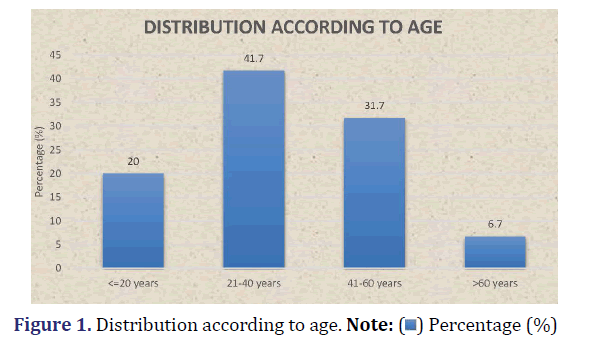
 ) Percentage (%)
) Percentage (%)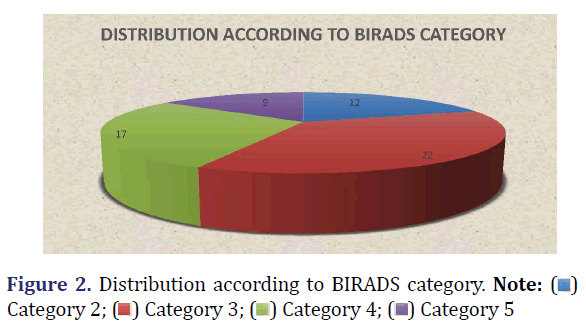
 )
Category 2; (
)
Category 2; ( ) Category 3; (
) Category 3; ( ) Category 4; (
) Category 4; ( ) Category 5
) Category 5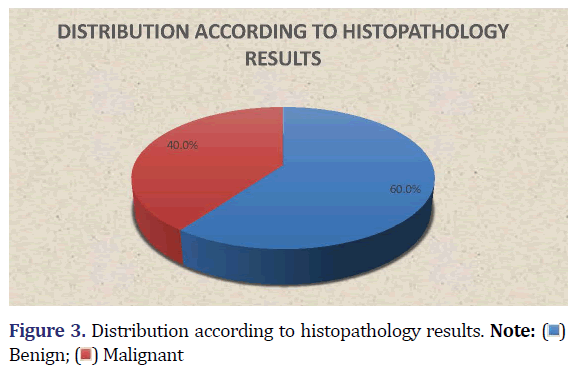
 )
Benign; (
)
Benign; ( ) Malignant
) Malignant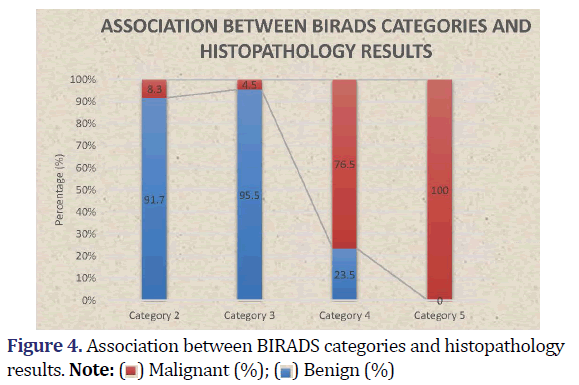
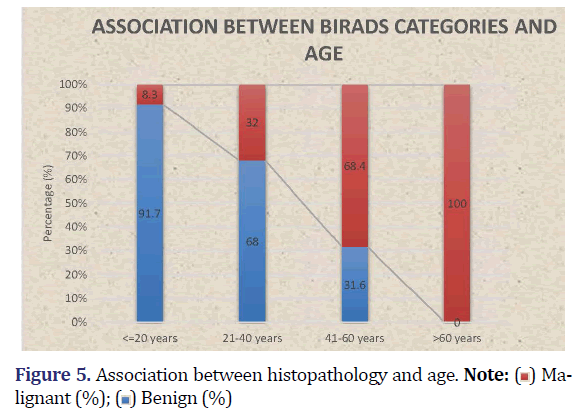


 ) Cat 5 (%); (
) Cat 5 (%); ( ) Cat 4 (%); (
) Cat 4 (%); ( ) Cat 3 (%); (
) Cat 3 (%); ( ) Cat 2 (%)
) Cat 2 (%)